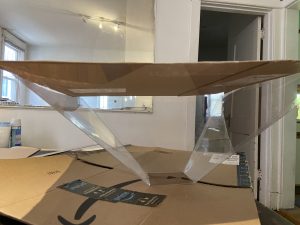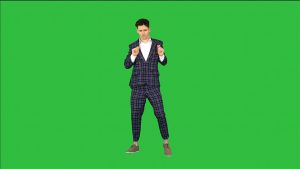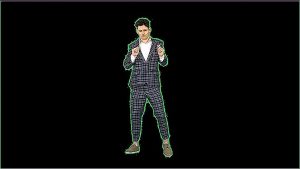This week, I worked on constructing the final full-size model of the holographic pyramid, which is currently at the level of detail needed for the MVP and interim demo, although we will make changes to make it clearer and more visibly professional for the final presentation.
One unexpected issue was that unlike the smaller prototypes, the full-size model’s walls sagged slightly at the center of the edges, which distorts images reflected off of the sides. Thanks to Jullia’s excellent suggestion, I cut out and taped a cardboard square above the pyramid, which adequately straightens the sides of the pyramid. This cardboard top also has the benefit of dimming the light immediately under the pyramid, which will improve the visibility of reflected images. For our final model, we will improve our pyramid by painting the cardboard black.


Figure 1: The holographic pyramid adjacent to its 1:2-size model. Despite the 1:2 size model’s perfect proportions, the full-size model’s walls sag slightly, especially in the center.
Figure 2: The holographic pyramid with a cardboard top. By virtue of being taped to the cardboard square, the pyramid’s sides sag significantly less.
Also during this week, I also implemented our desired image filters (chroma-keying, brightness, and sharpness) in Python. This enables customization of constants (such as the aggressiveness of the background removal, increase in brightness, etc.) and testing out the filters on the camera images before implementation in hardware. An example of the filters (not using output from the OV7670 cameras) is shown below:

Figure 1: The original test image
Figure 2: The test image through chroma-keying, brightness, and sharpening filters. The chroma-keying software implementation was hard-coded to remove the specific background color in the image.
I am on track with the updated schedule, in which software implementations of the image filters was moved to this past week, and the live studio construction was moved to next week. Over the next week, I will construct the live studio, possibly with Jullia’s assistance (depending on how busy she is with further hardware implementations). Additionally, I will also finish up the software implementations of the image filters by running them on images captured from our OV7670 cameras. I will also research and implement simple algorithms for noise removal in software to work with the OV7670’s chromatic noise, such as by using a low pass or median filter. It is likely that our sharpening filter may be replaced with a noise removal filter instead, although our final design may include both.